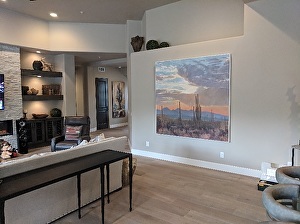
In my last post, I shared my thoughts on the health and vitality of the art market. I believe that the art market is the strongest it’s been in some time and that it is a good idea for artists and gallery owners to be actively working to increase sales. I believe that it is a common misconception among many artists that the market is weak and that efforts to sell art are a waste of time.
Today I would like to address and attempt to dispel another common myth among artists and gallerists: the misconception that art “sells itself.”
The thinking behind this conception is based in some reality. The idea is that art is a very personal thing and that an art buyer who discovers a piece of art that speaks to their soul will respond to that art by buying it. When the connection is strong enough, the thinking goes, the viewer will purchase.
The underlying idea is, in my experience, generally correct. Most art buyers are making an emotional connection to a piece of art before they buy, and there have certainly been instances where a visitor to our gallery has discovered a piece of art, fallen in love, and approached me or a staff member with credit card in hand, ready to buy. These kinds of sales are very gratifying, and it’s almost inevitable that every artist is going to, at some point, encounter this kind of purchase.
The problem is that these kinds of effortless sales are a very small percentage of all of the art sales that are made. Most sales require work and salesmanship to close, and any artist or gallerist who waits around for the sales to come to them is inevitably going to miss out on many sales opportunities.
Many buyers will fall in love with art only to immediately begin the process of talking themselves out of making the purchase. The problem is that once someone starts thinking about the reasons not to buy, they quickly realize that there are many more reasons not to make the purchase than there are to make one.
I’ve watched buyers wrestle with themselves, and, though I can’t read minds, I suspect that fear is the main demotivator when it comes to the decision to buy. People are afraid that, though they love a piece of art, it might be too expensive, or maybe it’s the wrong colors for their home, or maybe it’s not the right size, or maybe they have bad taste . . .
The list of possible doubts is long and can quickly outweigh their desire to purchase.
It’s our job to help the buyer overcome these concerns or to prevent the buyer from giving thought to them in the first place. This doesn’t mean we have to counter every possible concern, it just means that we have to provide the potential buyer more reasons to buy than they have excuses not to buy. We can also help our buyers solve any doubts or problems as they arise.
Selling art successfully requires skill, patience, and experience. I’m sure that those of you who have been selling art for some time have seen your success rate rise over time as you learn how to talk to your customers and how to help them overcome their doubts. While the art you are producing has doubtless evolved and improved, I would argue that your skill as a salesperson has been even more critical to your increase in sales.
With that in mind, I encourage every artist to do two things. First, I encourage you to become a serious student of salesmanship. I know that the word “salesmanship” has a negative connotation because of the unfortunate disrepute brought on the trade by unethical and pushy salespeople, but I urge you to set aside the distaste you might harbor toward the sales process so that you can learn effective sales techniques.
Remember, a true salesperson isn’t a huckster or thief, and salesmanship isn’t cajoling or forcing. Salesmanship is the art of helping people acquire what they desire. This is especially true when selling art. Art enriches people’s lives immeasurably, and if you can learn some basic salesmanship skills that will help you help your customers, they will thank you for it.
The second important thing you can do to become a better salesperson is to seek as many opportunities to sell as you can find. Experience is the best teacher. Every chance you have to interact with customers will help you refine your approach to working with customers and closing sales. Art shows, festivals, and open studio tours can be a great way for artists to gain exposure and get concentrated doses of sales experience.
If you are studying the theory of salesmanship and then taking every opportunity to put theory into practice, you will see a steady increase in your ability to sell your art. Expertise in salesmanship is more important than it has ever been as self-promotion becomes more important in the art market. Even artists who would ultimately like to be selling in galleries will benefit by understanding the sales process.
How Are your Sales Skills?
What have you done to improve your sales skills? What do you feel are the most important things you have learned as you’ve gained experience selling your art? What are the biggest challenges you feel you face as you interact with customers in an attempt to sell your art?
